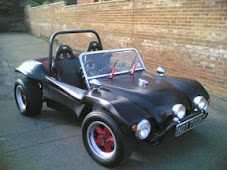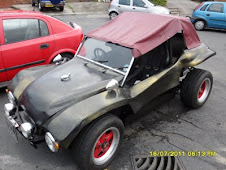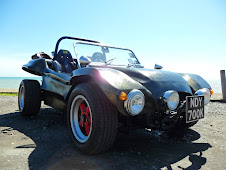 Previously in the last article I have cut away the body to allow access to install the IRS brackets which are part of the IRS conversion. I had downloaded the Internet article at http://bajaclub.co.uk/PDF_Documents/IRS.PDF from Airsouls. Although this article was written quite well it did not adequately explain the process of cutting in the brackets. As this is the most important part of the IRS conversion this was something that I would new to spend time over.
Previously in the last article I have cut away the body to allow access to install the IRS brackets which are part of the IRS conversion. I had downloaded the Internet article at http://bajaclub.co.uk/PDF_Documents/IRS.PDF from Airsouls. Although this article was written quite well it did not adequately explain the process of cutting in the brackets. As this is the most important part of the IRS conversion this was something that I would new to spend time over.The first thing which was obvious about the installation was that I would have to either buy; make or borrow a jig that would give me the proper position of the IRS brackets. Fortunately after placing an advertisement on Vzi I was soon in the position of two IRS jigs. One thing I have found with using other peoples jigs is that as you haven't made the jig, its really important to ensure that you know how it works and more importantly if it does.
I decided that I would have to try the jig on a 1303s chassis to ensure that the jig was correctly align
 ed. It was noticeable straight away that 1303s brackets where different to the ones that are available today. The other obvious difference was that the frame horns seemed to be a different shape . The jig fitted into the IRS brackets on the 1303s chassis . The noticeable thing about the jig on both sides was that the tube that was att
ed. It was noticeable straight away that 1303s brackets where different to the ones that are available today. The other obvious difference was that the frame horns seemed to be a different shape . The jig fitted into the IRS brackets on the 1303s chassis . The noticeable thing about the jig on both sides was that the tube that was att ached to the end was short on both of the jigs. The reason for this was that the jig would not be able to fit into the bush on the furthest end of the bracket if it was any longer. I returned home happily in the knowledge that the jig was ok and a reasonable fit.
ached to the end was short on both of the jigs. The reason for this was that the jig would not be able to fit into the bush on the furthest end of the bracket if it was any longer. I returned home happily in the knowledge that the jig was ok and a reasonable fit.It was at this point that an child hood illusion was shattered. I had always thought that VW cars where superior because they used the metric measuring system way before we adopted it in the UK. When trying to locate a suitable bolt that would fit the brackets this turned out to be 1/2" UNC. Well as you can see the myth was not true.
I took th
 e jigs back to the garage. The first thing I needed to do was to cut away the metal where the bracket fitted into the frame.
e jigs back to the garage. The first thing I needed to do was to cut away the metal where the bracket fitted into the frame.  You can see in the pictures I started by removing material from the flange that braces the frame horn to the torsion tube. I took the material away to the handbrake cable guides. I new I would have to remove more material and take the flange back further before the bracket would fit in and not foul the IRS Arm when it was in place. The next thing I was going to have to do was to use the jig to locate on the bolt hole on the side of the frame arm. To do this the jig would have to be placed on to the car.
You can see in the pictures I started by removing material from the flange that braces the frame horn to the torsion tube. I took the material away to the handbrake cable guides. I new I would have to remove more material and take the flange back further before the bracket would fit in and not foul the IRS Arm when it was in place. The next thing I was going to have to do was to use the jig to locate on the bolt hole on the side of the frame arm. To do this the jig would have to be placed on to the car. I needed to remove more material from the flange on the frame horn so the length of the bracket would fit alongside the frame horn. With the Jig in place on each side the and done up enough for the arm of the jig to make contact with the frame arm. I could use a black marker to draw around the outs
I needed to remove more material from the flange on the frame horn so the length of the bracket would fit alongside the frame horn. With the Jig in place on each side the and done up enough for the arm of the jig to make contact with the frame arm. I could use a black marker to draw around the outs ide of the bolt hole. I then used a Starrett 1 3/4" or 32mm type hole saw to cut out the hole were the bracket protruded through. It is important to note that when you mark the holes you have marked the circumference of a circle.You must ensure you have a centre point of this circle before pop marking and drilling. This can be achieved by using dividers or compass.
ide of the bolt hole. I then used a Starrett 1 3/4" or 32mm type hole saw to cut out the hole were the bracket protruded through. It is important to note that when you mark the holes you have marked the circumference of a circle.You must ensure you have a centre point of this circle before pop marking and drilling. This can be achieved by using dividers or compass.  The hole can be troublesome to cut out as it is very tight to get a drill and Starrett hole saw into you may find that the only way to do this is to purchase right angle conversion for your drill, these are exceptional for getting into tight spaces. The one pictured right came with a key less 10mm chuck for £9.99. I added an £18, 13mm keyed chuck onto it so that I could fit the Starrett arbour which was 1/2" into it . With this hole cut out the bracket could be slipped into this hole and positioned on the rear torsion bar to gain its eventual position. I used this method to locate the position of the bracket on both sides. The main reas
The hole can be troublesome to cut out as it is very tight to get a drill and Starrett hole saw into you may find that the only way to do this is to purchase right angle conversion for your drill, these are exceptional for getting into tight spaces. The one pictured right came with a key less 10mm chuck for £9.99. I added an £18, 13mm keyed chuck onto it so that I could fit the Starrett arbour which was 1/2" into it . With this hole cut out the bracket could be slipped into this hole and positioned on the rear torsion bar to gain its eventual position. I used this method to locate the position of the bracket on both sides. The main reas on for this was that on the Baja club IRS conversion the hole was made too large. Additionally the bracket did not sit entirely in the hole so it had to be cut out precisely. The angle that the brackets protruded from the torsion bar where then compared and adjusted so they where the same, luckily no adjustment was needed. I cut the holes out easily a
on for this was that on the Baja club IRS conversion the hole was made too large. Additionally the bracket did not sit entirely in the hole so it had to be cut out precisely. The angle that the brackets protruded from the torsion bar where then compared and adjusted so they where the same, luckily no adjustment was needed. I cut the holes out easily a nd tried the brackets on each side. I found the driver side (left picture) still required more material to be cut from the flange to allow the bracket to be fitted and marked. This bought the flange under the handbrake cable and would mean that the cable position might need to be changed. It appeared different from the passenger side as it was not interfering with the bracket like the drivers side was.
nd tried the brackets on each side. I found the driver side (left picture) still required more material to be cut from the flange to allow the bracket to be fitted and marked. This bought the flange under the handbrake cable and would mean that the cable position might need to be changed. It appeared different from the passenger side as it was not interfering with the bracket like the drivers side was.With the holes cut and the bracket positions marked. The
 gauge of the metal could be seen easily with the holes cut and looked to be no more
gauge of the metal could be seen easily with the holes cut and looked to be no more than 2mm. I could start removing material from the torsion bar end working towards the rear of the car. This w
than 2mm. I could start removing material from the torsion bar end working towards the rear of the car. This w as going to be a slow procedure of cutting a strip back then trying the jig and bracket in place until a good fit was made. I would start by removing half and then use smaller increments on each cut back. I new the end of the bracket was supposed to sit outside the frame arm thankfull
as going to be a slow procedure of cutting a strip back then trying the jig and bracket in place until a good fit was made. I would start by removing half and then use smaller increments on each cut back. I new the end of the bracket was supposed to sit outside the frame arm thankfull y to a picture in the Airsouls article on the bajaclub website.
y to a picture in the Airsouls article on the bajaclub website.Once the brackets where made to fit, the jig and bracket where then fully done up in preparation of the brackets being tacked in place. Before they where tacked in I went back and took more measurements of the original brackets to ensure everything was in line and in place. When I tried to get my Arc welder running on my Honda Generator I soon found that it drew too much current from the generator to weld with. I would have to hire a welder generator for machine hire company to allow me to get the brackets welded in and the new A Arms fitted.
Cont.






















No comments:
Post a Comment